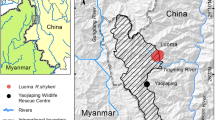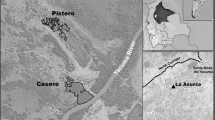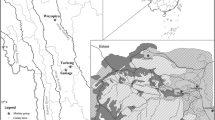Abstract
Findings of regional variations in the behavioral patterns of non-human primates have led to the vigorous study of animal traditions (or culture), which contribute to a biological understanding of diversity in human cultures. Although our knowledge of behavioral variations of the bonobo (Pan paniscus) is limited compared with its sister species, the chimpanzee (P. troglodytes), variations in the prey of this species have been reported across study sites. This study describes evidence of mammals consumed by bonobos in the Iyondji site, which was established in 2010. We found evidence that Iyondji bonobos consumed duikers (Cephalophus dorsalis, C. monticola) and diurnal monkeys (Cercopithecus ascanius), which is notable because only anomalures (Anomalurus spp.) are consumed by bonobos in Wamba, a long-term study site established in 1973, located in an area adjacent to Iyondji. Moreover, bonobos do not transfer between the two populations due to the river between the sites. According to our census of duikers and diurnal monkeys, Iyondji bonobos appeared to encounter diurnal monkeys more frequently than did Wamba bonobos. Although humans have apparently had a more pronounced impact on the habitats in Wamba than on those in Iyondji, it remains unclear how such environmental conditions may have contributed to the differences in the prey consumed by bonobos in different sites. Our findings suggest that additional research at various sites could reveal the nature of the variations in the behavior of bonobos.

Similar content being viewed by others
References
Badrian N, Malenky RK (1984) Feeding ecology of Pan paniscus in the Lomako Forest, Zaire. In: Susman RL (ed) The pygmy chimpanzee, evolutionary biology and behavior. Plenum Press, New York, pp 275–299
Bermejo M, Illera G, Pi JS (1994) Animals and mushrooms consumed by bonobos (Pan paniscus): new records from Liungu (Ikela), Zaire. Int J Primatol 15:879–898
Boesch C (1996) Three approaches for assessing chimpanzee culture. In: Russon AE, Bard KA, Parker ST (eds) Reaching into thought: the minds of great apes. Cambridge University, Cambridge, pp 404–429
Boesch C, Boesch H (1989) Hunting behavior of wild chimpanzees in the Tai National Park. Am J Phys Anthropol 78:547–573
Dupain J, Fowler A, Kasalevo P, Sakamaki T, Bongoli L, Way T, Williams D, Furuichi T, Facheux C (2013) The process of creation of a new protected area in the Democratic Republic of Congo: the case of the Iyondji Community Bonobo Reserve. Pan Afr News 10:10–13
Fruth B, Hohmann G (2002) How bonobos handle hunts and harvests: why share food? In: Boesch C, Hohmann G, Marchant LF (eds) Behavioural diversity in chimpanzees and bonobos. Cambridge University Press, Cambridge, pp 231–243
Furuichi T, Idani G, Ihobe H, Kuroda S, Kitamura K, Mori A, Enomoto T, Okayasu N, Hashimoto C, Kano T (1998) Population dynamics of wild bonobos (Pan paniscus) at Wamba. Int J Primatol 19:1029–1043
Furuichi T, Idani G, Ihobe H, Hashimoto C, Tashiro Y, Sakamaki T, Mulavwa MN, Yangozene K, Kuroda S (2012) Long-term studies on wild bonobos at Wamba, Luo Scientific Reserve, D. R. Congo: towards the understanding of female life history in a male-philopatric species. In: Kappeler PM, Watts DP (eds) Long-term field studies of primates. Springer, Berlin/Heidelberg, pp 413–433
Furuichi T, Sanz C, Koops K, Sakamaki T, Ryu H, Tokuyama N, Morgan D (2015) Why do wild bonobos not use tools like chimpanzees do? Behaviour 152:425–460
Gilby IC, Eberly LE, Wrangham RW (2008) Economic profitability of social predation among wild chimpanzees: individual variation promotes cooperation. Anim Behav 75:351–360
Hayashi M, Ohashi G, Ryu HJ (2012) Responses toward a trapped animal by wild bonobos at Wamba. Anim Cogn 15:731–735
Hirata S, Yamamoto S, Takemoto H, Matsuzawa T (2010) A case report of meat and fruit sharing in a pair of wild bonobos. Pan Afr News 17:21–23
Hohmann G, Fruth B (1993) Field observations on meat sharing among bonobos (Pan paniscus). Folia Promatol 60:225–229
Hohmann G, Fruth B (2003a) Culture in bonobos? Between-species and within-species variation in behavior. Curr Anthropol 44:563–571
Hohmann G, Fruth B (2003b) Lui Kotal—A new site for field research on bonobos in the Salonga National Park. Pan Afr News 10:25–27
Hohmann G, Fruth B (2008) New records on prey capture and meat eating by bonobos at Lui Kotale, Salonga National Park, Democratic Republic of Congo. Folia Primatol 79:103–110
Hosaka K, Nishida T, Hamai M, Matsumoto-Oda A, Uehara S (2001) Predation of mammals by the chimpanzees of the Mahale Mountains, Tanzania. In: Galdikas BMF, Briggs NE, Sherman LK, Shapiro GL, Goodall J (eds) All apes great and small, vol 1., African apesKluwer/Plenum, New York, pp 107–130
Idani G, Mwanza N, Ihobe H, Hashimoto C, Tashiro Y, Furuichi T (2008) Changes in the status of bonobos, their habitat, and the situation of humans at Wamba in the Luo Scientific Reserve, Democratic Republic of Congo. In: Furuichi T, Thompson J (eds) The bonobos: behavior, ecology, and conservation. Springer, New York, pp 291–302
Ihobe H (1990) Interspecific interactions between wild pygmy chimpanzees (Pan paniscus) and red colobus (Colobus badius). Primates 31:109–112
Ihobe H (1992) Observations on the meat-eating behavior of wild bonobos (Pan paniscus) at Wamba, Republic of Zaire. Primates 33:247–250
Imanishi K (1952) Evolution of humanity. In: Imanishi K (ed) Man. Mainichi-Shinbun-sha, Tokyo, pp 36–94 (in Japanese)
Kano T (1992) The last ape: pygmy chimpanzee behavior and ecology. Stanford University Press, Stanford
Kawamoto Y, Takemoto H, Higuchi S, Sakamaki T, Hart JA, Hart TB, Tokuyama N, Reinartz GE, Guislain P, Dupain J, Cobden AK, Mulavwa MN, Yangozene K, Darroze S, Devos C, Furuichi T (2013) Genetic structure of wild bonobo populations: diversity of mitochondrial DNA and geographical distribution. PLoS One 8(3):e59660
Laland KN, Janik VM (2006) The animal cultures debate. Trends Ecol Evol 21:542–547
McGrew WC (1992) Chimpanzee material culture: implications for human evolution. Cambridge University Press, Cambridge
McGrew WC, Tutin CEG (1978) Evidence for a social custom in wild chimpanzees? Man 13: 234–251
Nackoney J, Molinario G, Potapov P, Turubanova S, Hansen MC, Furuichi T (2014) Impacts of civil conflict on primary forest habitat in northern Democratic Republic of the Congo, 1990–2010. Biol Conserv 170:321–328
Nishida T (1987) Local traditions and cultural transmission. In: Smuts BB, Cheney DL, Seyfarth RM, Wrangham RW, Struhsaker TT (eds) Primate societies. University of Chicago Press, Chicago, pp 462–474
Nishida T, Matsusaka T, McGrew WC (2009) Emergence, propagation or disappearance of novel behavioral patterns in the habituated chimpanzees of Mahale: a review. Primates 50:23–36
Sakamaki T, Kasalevo P, Bokamba MB, Bongoli L (2012) Iyondji Community Bonobo Reserve: a recently established reserve in the Democratic Republic of Congo. Pan Afr News 19:16–19
Stanford CB (1998) The social behavior of chimpanzees and bonobos: empirical evidence and shifting assumptions. Curr Anthropol 39:399–420
Surbeck M, Fowler A, Deimel C, Hohmann G (2009) Evidence for the consumption of arboreal, diurnal primates by bonobos (Pan paniscus). Am J Primatol 71:171–174
Tashiro Y (2001) Newly observed cases of meat eating by bonobos at Wamba, DR Congo. Primate Res 17:271–275 (in Japanese, with English summary)
Tennie C, Gilby IC, Mundry R (2009) The meat-scrap hypothesis: small quantities of meat may promote cooperative hunting in wild chimpanzees (Pan troglodytes). Behav Ecol Sociobiol 63:421–431
Terada S, Nackoney JR, Sakamaki T, Mulavwa MN, Yumoto T, Furuichi T (2015) Habitat use of bonobos (Pan paniscus) at Wamba: selection of vegetation types for ranging, feeding and night-sleeping. Am J Primatol 77:701–713
White FJ (1992) Pygmy chimpanzee social organization: variation with party size and between study sites. Am J Primatol 26:203–214
White FJ (1994) Food sharing in wild pygmy chimpanzees, Pan paniscus. In: Roeder JJ, Thierry B, Anderson JR, Herrenschmidt N (eds) Current primatology, vol 2., Social development, learning and behaviorUniversite Louis Pasteur, Strasbourg, pp 1–10
Acknowledgments
We thank the Ministry of Scientific Research and Technology in the Democratic Republic of the Congo (DRC) for research permits, the Centre de Recherche en Ecologie et Foresterie and the University of Kinshasa for their scientific collaboration, and the Forêt des Bonobos, the African Wildlife Foundation (AWF), and the Institut Congolais pour la Conservation de la Nature (ICCN) for various types of support of our work in the Iyondji Community Bonobo Reserve. We also thank local assistants in Iyondji and Wamba, members of the Wamba Committee for Bonobo Research, and the Primate Research Institute (PRI) of Kyoto University for support in the field and at their offices; we are grateful to Dr. Yoshihiro Nakashima for advice on camera traps. We would like to express our special gratitude to Dr. Gottfried Hohmann for useful comments and valuable information at Lui Kotale. This study was financially supported by the Japanese Ministry of the Environment Global Environment Research Fund (D-1007 to Furuichi), the JSPS HOPE project of the PRI of Kyoto University (to Matsuzawa), a US Fish and Wildlife Service Assistance Award (96200-0-G017 to AWF), a MEXT special Grant (“Human evolution”), and the JSPS Strategic Young Overseas Visits Program for Accelerating Brain Circulation (S2508).
Author information
Authors and Affiliations
Corresponding author
About this article
Cite this article
Sakamaki, T., Maloueki, U., Bakaa, B. et al. Mammals consumed by bonobos (Pan paniscus): new data from the Iyondji forest, Tshuapa, Democratic Republic of the Congo. Primates 57, 295–301 (2016). https://doi.org/10.1007/s10329-016-0529-z
Received:
Accepted:
Published:
Issue Date:
DOI: https://doi.org/10.1007/s10329-016-0529-z




